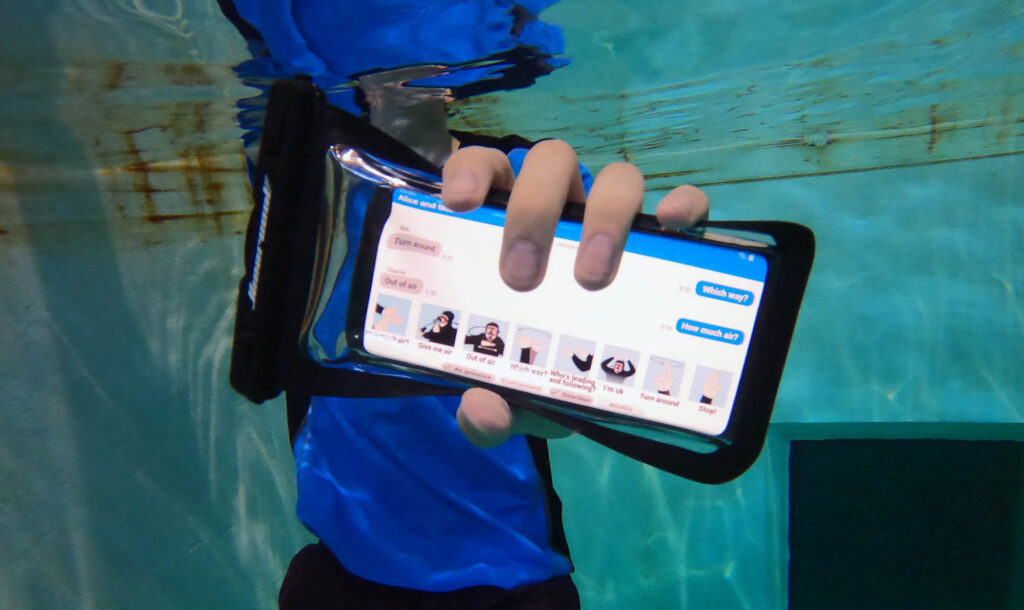“AquaApp brings underwater communication to the masses.” That’s the bold claim of scuba diver Prof Shyam Gollakota. “The state of underwater networking today is similar to ARPANET, the precursor of the Internet, in the 1970s, where only a select few had access to the Internet.
“AquaApp has the potential to change that status quo by democratising underwater technology and making it as easy as downloading software on your smartphone.”
Unless you use a full-face mask with comms system, for most divers hand signals are the only practical way to communicate safety and directional information under water, as reflected in the recent Divernet feature Dive Like A Pro: Learn To Communicate Underwater.
Now University of Washington researchers hope to change that, having developed what they describe as “the first mobile app for acoustic-based communication and networking under water that can be used with divers’ existing devices such as smartphones and smartwatches”.
“The project is in part motivated by experiences diving with my friends, as well as snorkelling, where communicating is a challenge since it requires lifting the head at the same time as the other person, which is hard to co-ordinate,” Prof Gollakota told Divernet.
Hand signals can be misinterpreted and cause confusion, especially over distance and in low visibility, say the team, and while two-way text messaging might provide a solution it requires costly and difficult-to-access custom hardware.

“Smartphones rely on radio signals like wi-fi and Bluetooth for wireless communication. Those don’t propagate well under water, but acoustic signals do,” says Tuochao Chen, co-lead author with Justin Chan of the AquaApp study. The two PhD students at the university’s Paul G Allen School worked on the project with Prof Gollakota, director of the school’s Mobile Intelligence Lab.
“With AquaApp, we demonstrate underwater messaging using the speaker and microphone widely available on smartphones and watches,” says Chen. “Other than downloading an app to their phone, the only thing people will need is a waterproof phone-case rated for the depth of their dive.”
How it works
Using the AquaApp interface, divers can select from a list of 240 pre-set messages that correspond to hand signals employed by professional divers, with the 20 most common (those likely to be used by recreational divers) prominently displayed for easy access. Messages can also be filtered into eight categories such as directional indicators, environmental factors or equipment status.
“The underwater scenario surfaces new problems compared to applications over the air,” says Chan. “For example, fluctuations in signal strength are aggravated due to reflections from the surface, floor and coastline. Motion caused by nearby humans, waves and objects can interfere with data transmission. Further, microphones and speakers have different characteristics across smartphone models.



“We had to adapt in real time to these and other factors to ensure that AquaApp would work under real-world conditions,” he says. Those “other factors” include devices’ tendency to rapidly shift position and proximity in current, and noise from nearby vessels and marine animals.
AquaApp uses an algorithm to optimise the bitrate and acoustic frequencies of each transmission in real time, based on parameters such as distance, noise and frequency response variations.
When diver A wants to send a message to diver B’s device, A’s app first transmits a quick note called a “preamble”. AquaApp on diver B’s device runs the algorithm to determine the best conditions to receive the preamble and instructs A’s device to send the message using those conditions.
Underwater network
Having developed a networking protocol to share access to the underwater network, the team say that AquaApp can accommodate up to 60 unique users on its local network at one time.
The researchers then evaluated AquaApp’s performance, at distances of up to 113m and depths to 12m. “Twelve metres was the maximum depth we could test at, since we need to measure the distance accurately,” says Prof Gollakota. “Commercial smartphone waterproof cases can support larger depths of up to 40m.”

The six test sites represented different water conditions and activity levels and included beneath a bridge in calm water, at a popular waterfront park with strong currents, beside the fishing dock of a busy lake and in a bay with strong waves.
“Based on our experiments, up to 30m is the ideal range for sending and receiving messages under water, and 100m for transmitting SOS beacons,” says Chen. “These capabilities should be sufficient for most recreational and professional scenarios.”
The team also ran the system continuously on two Samsung Galaxy S9 smartphones at maximum volume with screens activated to measure AquaApp’s impact on battery life. Power was reduced by no more than 32% over the course of four hours, they report.
“We have made the code and app available on GitHub for people to test it out,” Prof Gollakota told Divernet. “We’re in the process of looking for industry partners to make this commercially available. The good news is that since it is only software and not hardware, the hurdles and timeline should be smaller compared to traditional diving equipment.”
Data and open-source Android code are also available on the AquaApp website, and there is also a demonstration video. Now the question is the extent to which divers will embrace this development.

